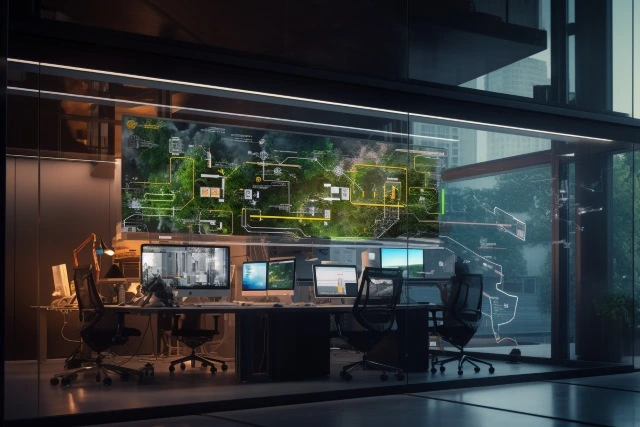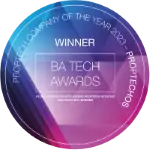With the massive technological advancements throughout recent years, adopting digital tools has become a necessity rather than a luxury. Computer-aided facility management is at the heart of this digital adoption in the facilities management sector. This software solution digitizes facility management processes to streamline workflows and optimize facility efficiency.
What is computer-aided facility management?
Computer-aided facility management (CAFM) emerged as a pivotal element in the digital transformation in facilities management. Developed in response to the growing complexity and scale of facilities needing more efficient management strategies, CAFM encompasses all digital tools that support facility management. This includes software, hardware, and other digital services that assist in planning, executing, and monitoring all facility management activities.
CAFM provides a holistic overview of a facility’s operations, from coordinating maintenance activities to managing space and tracking assets. The confluence of technology and facility management enables managers to carry out their tasks more efficiently and effectively.
The synergy between CAFM and CAD: Design meets management
Most CAFM systems offer built-in support for computer-aided design (CAD) formats. This makes integrating CAD schematics of your facilities and equipment a simple process with significant results. By integrating these CAD designs into your management system, you allow your facility managers to:
- Visualize space utilization: Facility managers can use CAD designs in CAFM to see how spaces are used in real-time, aiding in more effective space planning and management.
- Plan effectively: CAD designs provide a detailed facility layout, allowing facility managers to plan activities, such as maintenance or renovations, without disrupting the workflow.
- Better manage assets: By mapping assets to the CAD designs in the CAFM system, managers can track the location of assets in real-time, making asset management more efficient.
- Enhance maintenance management: CAFM systems can use CAD designs to provide visual contexts for maintenance tasks, making it easier to identify where work needs to be done.
- Improve emergency preparedness: CAD designs can help facility managers plan emergency routes and safety procedures, enhancing the organization’s emergency preparedness.
How is CAFM different from CMMS?
While CAFM and computerized maintenance management systems (CMMS) share some similarities, they serve different purposes. A CMMS focuses more on maintenance management, while CAFM offers a broader spectrum of capabilities. It encompasses maintenance, space management, real estate, and lifecycle management, among other things.
Key features of CAFM software
CAFM software comes equipped with a wide range of features that enhance facility management. A few key features to look for when assessing it for the commercial real estate (CRE) industry include:
- Space management: Provides a visual representation of the facility’s spaces and their uses.
- Asset management: Tracks and manages all assets within the facility.
- Maintenance management: Schedules and tracks maintenance tasks.
- Environmental and sustainability tracking: Monitors sustainability metrics and environmental impact.
- Project management: Manages project timelines, resources, and tasks.
- Real estate portfolio management: Keeps track of all properties, leases, and real estate data.
Primary benefits of using CAFM software in commercial real estate
Using CAFM software in the CRE industry can give your organization a competitive edge. Key benefits that can help your organization include:
- Streamlined processes: Reduces the time and effort needed for various tasks by automating and optimizing operations.
- Unified data: Creates a unified view of all facility-related data, enabling informed decision-making.
- Enhanced productivity: Workflow automation in CAFM software streamlines tasks such as maintenance scheduling and space allocation, which improves productivity.
- Improved transparency: Provides stakeholders with an up-to-date snapshot of the facility’s status, improving transparency and communication.
When buildings get smart: CAFM, IoT, and AI
The integration of computer-aided facility management with the Internet of Things (IoT) and Artificial Intelligence (AI) has paved the way for the advent of smart buildings. These technologies intertwine to create a potent combination that elevates the capabilities of facility management to new heights, enhancing efficiency, sustainability, and cost-effectiveness.
Saving both planet and wallet with smarter management
Facility managers armed with modern technology can boost the performance and efficiency of their facilities in novel ways that help the earth and your bottom line.
- Environmental friendliness: Real-time data from IoT devices, coupled with the predictive analytics capabilities of AI, allow facility managers to optimize the efficiency of energy-consuming systems. It analyzes IoT data to understand facility uses and then adjusts facility system schedules to facilitate tenant needs without wasting resources on unused spaces. This can also help facilities meet the environmental standards of ESG green buildings.
- Reduced operational costs: Automating tasks with IoT data and CAFM tools lowers labor costs and allows staff members to work more efficiently. Repetitive tasks such as maintaining a maintenance schedule and updating space usage calendars can be entirely automated.
- Drive additional revenue: Using real-time data and analytics gives facility managers a deep understanding of space utilization. This deeper understanding allows them to identify new opportunities to enhance underutilized spaces. With half of office space being underutilized daily, space optimization can make a significant impact.
Predictive maintenance and AI-driven insights
One of the most powerful applications of AI in CAFM is predictive maintenance. By analyzing data from IoT devices, AI algorithms can predict when a piece of equipment might fail and schedule maintenance accordingly. This prevents costly downtime by up to 50% and extends the equipment’s lifespan by up to 40%. Additionally, AI can provide strategic insights, identify trends, and recommend improving facility management.
Implementing and adopting computer-aided facility management in your organization
Implementing CAFM software and training employees to use it effectively maximizes the potential it offers your facilities. Here’s a basic overview of such an implementation and training process:
- Needs analysis: The first step is to identify the specific needs of your facility. This includes understanding essential features like space management, asset tracking, maintenance scheduling, etc.
- Software selection: After identifying your needs, select a CAFM software that best meets them. Consider factors such as ease of use, integration capabilities with existing systems, and support services offered by the software provider.
- Data migration: Once you’ve chosen your specific software, the next step is migrating data from your existing systems to the new one. This may include CAD designs, asset databases, maintenance records, etc.
- System configuration: Configure the CAFM software to align with your facility’s operations. This might involve setting up user roles and permissions, creating maintenance schedules, and setting up alerts and notifications.
- Training: Whether it’s hands-on training sessions or instruction videos and manuals, ongoing support is necessary to ensure facility managers and other users understand how to use the new software. The training covers key areas such as inputting data, generating reports, scheduling maintenance, and managing assets.
- Testing and adjustment: After training, conduct a testing phase where users can use the system in a real-world setting. Gather feedback, make necessary adjustments, and provide additional training if needed.
- Rollout: After complete testing and all issues are resolved, fully implement the CAFM system. Continue to monitor the system and provide ongoing training and support.
Proptech integration for CRE advantage
Integrating Proptech into CAFM gives CRE businesses a significant advantage in the sector. Proptech solutions can further enhance the capabilities of facility management systems by offering specific solutions that cater to the unique needs of CRE businesses. This customizability allows companies to tailor the abilities of their CAFM software to align with their particular needs. Whether it’s integrating a solution specific to lease management or software to analyze tenant behavior, Proptech can fill any void in your management system.
As individual solutions, Proptech leads technological innovation within the CRE industry. So, integrating these solutions into CAFM software gives you access to the industry’s latest advancements.
You can integrate Proptech and your CAFM software with ease using ProptechOS. Acting as your building’s operating system, ProptechOS integrates all your digital tools for managing your CRE portfolio. This unifies your data, analytics, and automation tools to enhance the capabilities of your software solutions. Try ProptechOS for free today to see how to create a cohesive environment for your smart buildings.

Dr. Erik Wallin
Chief Ecosystem Officer, and founder of ProptechOS and RealEstateCore is recognized as a leader in Building Operating Systems (BOS) and making the buildings of the world smarter. He holds an MSc and a Ph.D. in Media and Computer Science from KTH Royal Institute of Technology.
Read his full bio and information here.

